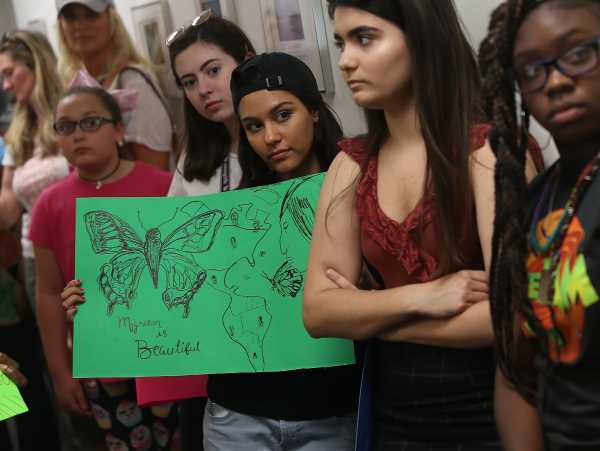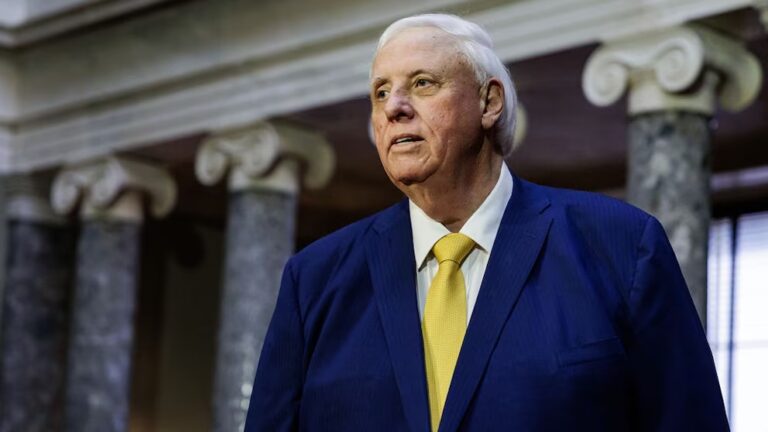
For several months, the Deferred Action for Childhood Arrivals (DACA) program has quietly shambled along in a zombielike state.
The Trump administration had announced in September 2017 that it was sunsetting the program, which had temporarily protected from deportation young adult unauthorized immigrants who came to the US as children.
But then this January, a federal court partially blocked the administration’s move, allowing some 700,000 unauthorized immigrants who were already protected under the program to renew their applications.
That limbo may come to an abrupt end in the next few weeks. A couple of court cases could determine whether DACA could be reanimated entirely — or killed for good.
On Friday, a federal judge in DC ruled to undo the administration’s decision to end DACA — and decreed that unless the Trump administration could get the DC Circuit Court to put a hold on his decision, it would have to start accepting new applications for protection under DACA on August 23.
But while the clock ticks in DC, a federal judge in Texas will hear a case trying to shut down DACA entirely — and the question isn’t whether the judge, known as an immigration hawk, will rule in favor of killing DACA, but when he’ll do it.
At some point, the government is almost certainly going to be under simultaneous mutually contradictory orders from two federal judges: to continue processing applications under DACA, and to stop doing just that.
It’s largely uncharted constitutional territory. The Supreme Court will almost certainly be asked to interrupt its summer recess to weigh in. But with only eight members on the Court, split 4-4 along ideological lines, it’s not clear whether the crisis will be resolved.
Ultimately, DACA’s days are numbered — that’s been true ever since President Donald Trump arrived in office. But the next few weeks will determine whether immigrants protected under the program will remain safe for a few more years, or whether they’ll start becoming vulnerable to deportation in the near future.
A federal judge in DC has vacated the decision to end DACA
When the administration moved to end DACA in 2017, everyone from blue states to colleges to advocacy groups to DACA recipients themselves filed lawsuits in federal court to keep the program alive. And federal judges, so far, have obliged.
Currently, the administration’s decision to stop accepting applications for two-year DACA renewals is on hold, stopped by nationwide preliminary injunctions in the Northern District of California and the Southern District of New York. (A preliminary injunction forces the government to stop enforcing a policy while the judge considers whether the policy is legal or not.)
The government has appealed both injunctions, but the courts move slowly (and the Justice Department’s attempt to skip directly to the Supreme Court was rebuffed in February).
Last Friday, a third court case, in the DC District, ruled even more aggressively against the Trump administration, and on a much more aggressive timeline.
Judge John Bates of the DC Circuit didn’t just put an injunction on the decision to end DACA. He ordered the DACA rollback to be vacated entirely — essentially sending the administration back to the drawing board, and forcing it to start accepting applications not just from immigrants already protected by DACA but from those who were eligible but hadn’t applied, or who had become eligible for it (for example, by turning 15) after the administration stopped accepting new applications.
Bates said the Trump administration had neither demonstrated that it thought through the consequences of ending DACA before pulling the trigger nor engaged in a serious legal analysis of the program before deciding it was probably unconstitutional.
Bates had already given the administration 90 days to offer a better explanation for ending DACA than the one it initially offered in September; he was not at all impressed with what they came up with. “A conclusory assertion that a prior policy is illegal, accompanied by a hodgepodge of illogical or post hoc policy assertions, simply will not do,” he wrote Friday.
But Bates put the pause button on his own order for 20 days, until August 23. That gives the Trump administration time to ask the DC Circuit Court of Appeals to pause Bates’s order indefinitely while the circuit court considers an appeal of the ruling itself — essentially, a preliminary injunction against the judge’s order rather than the administration’s policy. If the administration decides not to ask for a stay, or if the DC Circuit fails to grant one, then the decision to end DACA is officially vacated.
But by August 23, yet another federal lawsuit may have changed the legal landscape of the DACA fight entirely.
A judge in Texas will probably order the Trump administration to kill DACA
The Trump administration’s ostensible reason for ending DACA last fall — the reason that Judge Bates found so insufficient — is that it was worried the program was unconstitutional and couldn’t survive a legal challenge. Specifically, a group of red states led by Texas had been threatening to sue the Trump administration to end DACA if it didn’t kill the program on its own.
The administration acceded to the threat. But then the judges in California and New York ordered Trump to start accepting renewal applications again. So the red states went to court anyway to get DACA shut down for good — turning the legal battle into a two-front war. (The administration isn’t defending DACA in this lawsuit; instead, it’s allowed a group of advocates to step in and defend the program instead.)
The lawsuit against DACA is being heard by Judge Andrew Hanen in the Southern District of Texas. He’s generally known as an immigration hawk, and made his feelings about the unconstitutionality of DACA pretty well-known when he ruled against an attempted expansion of the program during President Barack Obama’s second term.
On Wednesday afternoon, Hanen will hear arguments over whether to issue a nationwide injunction of his own, which would stop the Trump administration from continuing to implement DACA in any way. Immigration experts expect him to issue that injunction.
When and if that happens, the Trump administration will officially be under two conflicting injunctions from the courts. It will be under an order from Hanen to stop processing any DACA applications, and under orders from the judges in California and New York to continue processing DACA renewals. (And, depending on what’s happened in the DC case, potentially under orders to process new applications as well.)
If there’s any precedent for this, it hasn’t come up in constitutional lawyers’ discussion of the case on the internet so far. It’s truly uncharted territory.
The Supreme Court might sort out the dueling injunctions mess — or it might leave it up to the administration
As a general rule, when different judges in different areas of the country have issued conflicting opinions in a case, it becomes more likely that the Supreme Court will take up the case to sort out the inconsistency. But it usually does so at its own deliberate pace — which would likely result in the Court hearing one or more of the DACA cases in spring 2019, for a ruling that June.
But there’s a difference between conflicting opinions and conflicting orders about what the government is supposed to do right now.
It’s extremely likely that the Supreme Court will be asked to issue an emergency stay on Hanen’s ruling (unless the Fifth Circuit Court of Appeals does it for them) to prevent one anti-DACA ruling from trumping three pro-DACA ones.
What the Court will do is anyone’s guess. It might issue the stay and allow DACA to remain in effect per other judges’ orders until the case has fully come before SCOTUS. It might declare that Hanen’s ruling is in place for DACA recipients who live in the Fifth Circuit, but not in the rest of the country — or, conversely, that it’s in place everywhere but the Ninth Circuit, Second Circuit, and DC (where the other injunctions would be in effect). Or, in theory, it might declare that Hanen’s ruling somehow supersedes the other three.
Any of those, however, would require five justices to agree on the right path forward. And since Justice Anthony Kennedy formally retired in July — and the nominee to succeed him, Brett Kavanaugh, hasn’t yet been confirmed by the Senate — the eight justices on the Court are split 4-4 along ideological lines. Any ruling would require a justice to cross the aisle.
If the justices can’t issue a ruling, Hanen’s injunction would remain in place. But so would the other nationwide injunctions that contradicted Hanen. In other words, the question of what to do would remain open — it would just be up to the Trump administration to figure out what it’s supposed to do about DACA until the injunction gridlock is cleared.
It’s hardly a secret that the Trump administration would like to stop accepting DACA renewals — after all, that’s what it’s been trying to do for nearly a year. But it’s not clear whether they’re willing to get so aggressive that they accept the ruling of a single judge over the rulings of three others.
The legal mess turns the question of when to renew into a game of chance for DACA recipients
The legal mess forces DACA recipients to make a very difficult decision that could determine how long they get to stay and work in the US: When should they apply for another DACA renewal, knowing it could be their last?
Right now, literally anyone with a valid DACA work permit can apply for a renewal, even if their current permit doesn’t expire for months or years. That’s a change from the Obama administration, which accepted renewal applications only 150 days before a DACA recipient’s expiration. But the change wasn’t publicized at all — and even some professional immigration advocates didn’t know about it.
Protections from deportation and work permits under DACA are good for two years after they are issued. If your renewal application is granted while you still have six months on your last work permit, you have six months of overlap — and the last day that you’ll be able to work legally in the country only moves forward 18 months. So generally, there’s an incentive to apply for a renewal as close to the end of your first two-year grant as possible.
The plurality of DACA recipients — more than 300,000, according to DHS statistics from last fall — are set to lose their protections between January 1, 2019, and August 31, 2019. If they knew they’d be able to apply for renewals through next spring, it wouldn’t make any sense for them to apply now.
But due to the legal mishigas, they don’t actually know when the government might stop accepting renewal applications. So that calculus gets a lot weirder.
“The uncertainty of when the program will end creates incredibly stressful and perverse incentives where people are having to wonder if they should wait another nine months or whether they should apply now,” says Todd Schulte of the advocacy group FWD.us. Advocates like him are encouraging people to apply now.
Bates’s ruling aside, very few people think that DACA will ultimately survive its court battle. By the time the Supreme Court hears the full case, it will have a five-member conservative majority. And the worst-case scenario for the Trump administration is that the Supreme Court will give it a do-over on ending DACA.
But the difference between a work permit that expires after the next presidential election and one that expires in a matter of weeks is enormous. And with the court battle about to enter completely uncharted territory, no one can tell confused DACA recipients that they know exactly what the right decision should be.
Sourse: vox.com






